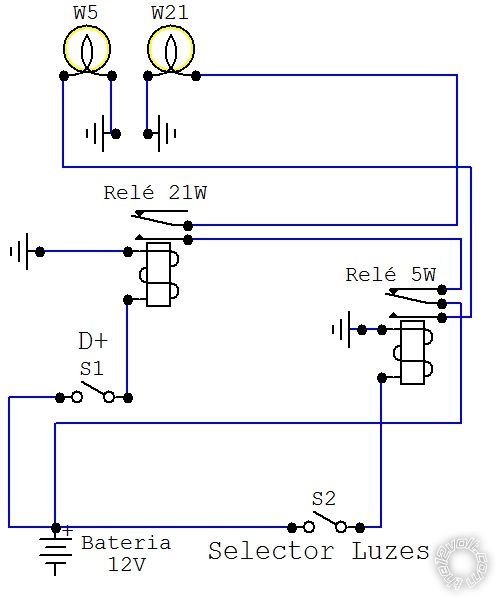drl relay
Printed From: the12volt.com
Forum Name: Relays
Forum Discription: Relay Diagrams, SPDT Relays, SPST Relays, DPDT Relays, Latching Relays, etc.
URL: https://www.the12volt.com/installbay/forum_posts.asp?tid=132220
Printed Date: January 01, 2026 at 3:42 AM
Topic: drl relay
Posted By: b3tn01hasd1s
Subject: drl relay
Date Posted: September 19, 2012 at 3:41 PM
So i need some help designing a circuit for my DRL's. The following are the constraints,
*On with blinkers
*on with Low Beams
*On for 30 seconds when unlock button from remote is hit
Thanks in Advance
Replies:
Posted By: b3tn01hasd1s
Date Posted: September 19, 2012 at 3:42 PM
BTW it is a 2006 honda accord lx. I am installing separate LED Strips
Posted By: howie ll
Date Posted: September 20, 2012 at 2:33 PM
A lot easier to simply wire them into your parking light or low beam circuit, on with blinkers might give you legal problems.
As for staying on why?
Use a DEI 528t timer either with your lock wire or an alarm's GWA wire.
-------------
Amateurs assume, don't test and have problems; pros test first. I am not a free install service.
Read the installation manual, do a search here or online for your vehicle wiring before posting.
Posted By: rfsduarte
Date Posted: January 16, 2013 at 2:07 AM
Posted By: turboled
Date Posted: January 16, 2013 at 7:17 AM
You can use a TPC module to let the LED flash with blinkers and steady with parking lights. If you have dual-color LEDs (amber + white) it's even better.
https://www.exledusa.com/exled-2color-2way-turn-position-lamp-control-module-tpc-v.2.html
Posted By: oldspark
Date Posted: January 16, 2013 at 8:05 AM
Although this was a sleeping 4-month old thread and I'm a bit puzzled by the circuit shown, that TPC is a good find.
It shows the hold-off behavior that I keep mentioning for these types of circuits - ie, the WHITE/ parkers stay off when a flashing signal is provided and hold off for about one second after the last flash.
That's required for any such flasher combined with clearance, stop, or reverse lights.
That TPC could probably drive a relay for normal bulbs (ie, 2 relays) or even have its output OR'd (2 diodes) for single-color LEDs or into a relay for combined stop/flasher bulbs etc.
Two TPCs are required - one per side. (Hence 4 relays, or 2 relays plus 4 diodes for the "single bulb" situation in which case I'd probably prefer my 2x DPDT relay solution with the repositioned flasher can.)
And it's 4 TPCs if using the scheme for each end - ie, rear is brakes or tails or reverse with flashers; front is parkers or DRLs with flashers.
Posted By: oldspark
Date Posted: January 17, 2013 at 6:33 PM
PS - I also noted exLED's TPC v.3 for R-LED as opposed to turboled's TPC v.2 - 2Color (2Way) Turn & parker.
I thought that by description the v.3 does what I described for v.2 with diodes and a single LED/bulb, but the info given is vague and they seem to show the same (youtube) video of its operation.
Posted By: turboled
Date Posted: January 17, 2013 at 7:47 PM
I believe I was mistaken too... v2 seems to work with 2 independent LED bulbs (2 positives, common ground) while the v3 works by reversing the polarity.
Posted By: oldspark
Date Posted: January 17, 2013 at 8:19 PM
Your interpretation is certainly better than mine!
I assume one thing from the title, but something different when looking at the number of wires etc.
But I am certainly grateful that you linked that product. Thanks!
I was thinking of contacting them not only for a "well done" etc, but also to ask for output current capability as well as an operational clarification.
Mind you, with an 8-pin PICAXE 08 it isn't too hard to program. They are less than $5 each (08M2, viz the PIC12F1840) and a single 08M2 should do both sides with ease, and 4 corners etc with a bit of trickery (ie, combining inputs thru a resistive voltage ladder etc) else a bigger PIC could be used.
Those PICs merely require a 5V regulator (small 3-pin type) maybe with some added +12V vehicle spike protection, power filter cap(s), and suitable output drivers for lams, LEDs or relays (eg. MOSFETs or transistors).
Plus the essential 2 on-board programming resistors and a serial programming interface (PC serial else via USB-serial converter) and the programming using the free tools available.
There's a bit of a learning curve but there are heaps of open-source examples and public links.
And once done, almost anything is possible, and analogaly complex things become quite easy and cheap (eg, switching and dimming of LEDs for timed circuits like puddle lights or stop/flashers or flashing stop lights and combined stop & tail LEDs/bulbs etc).
|
